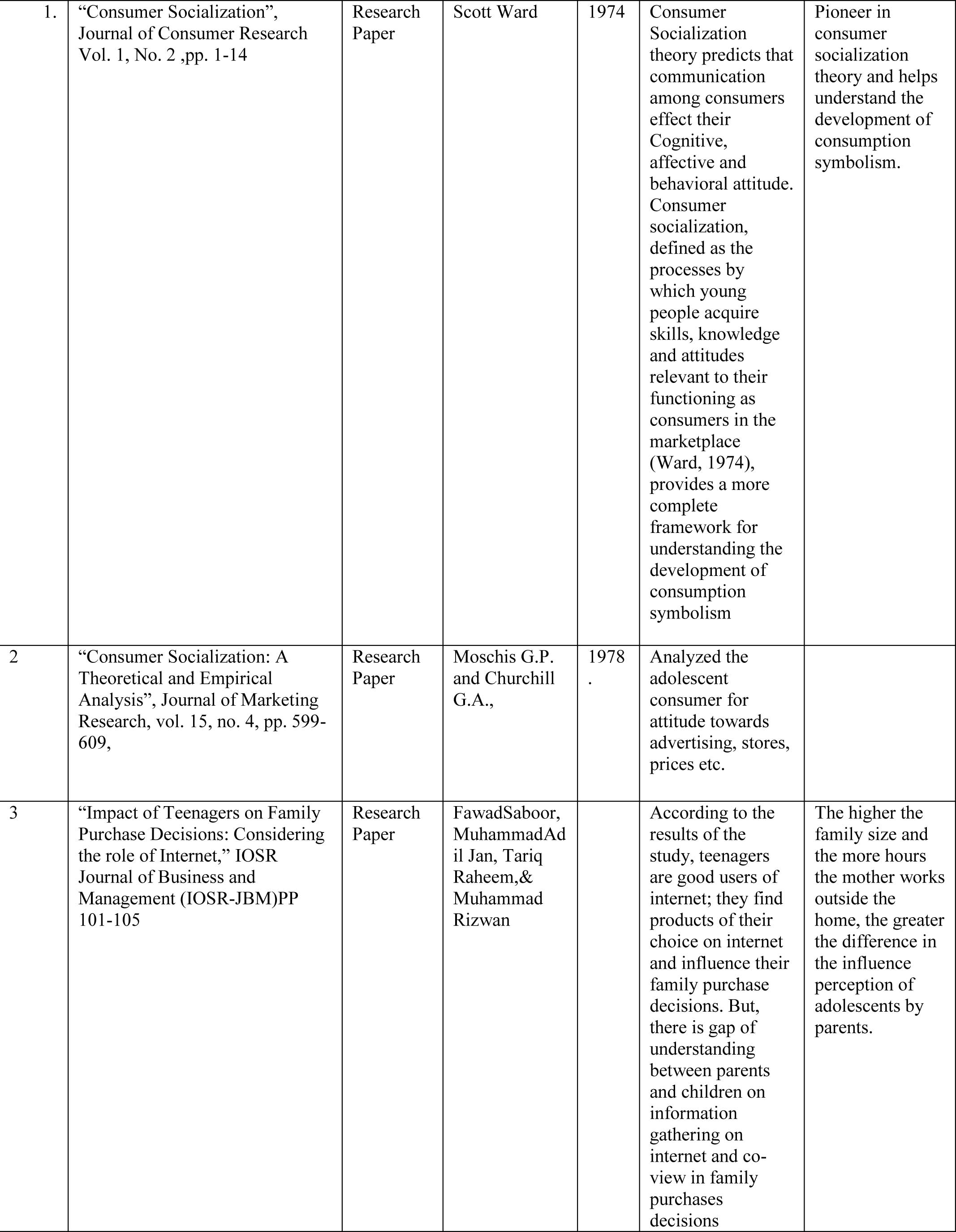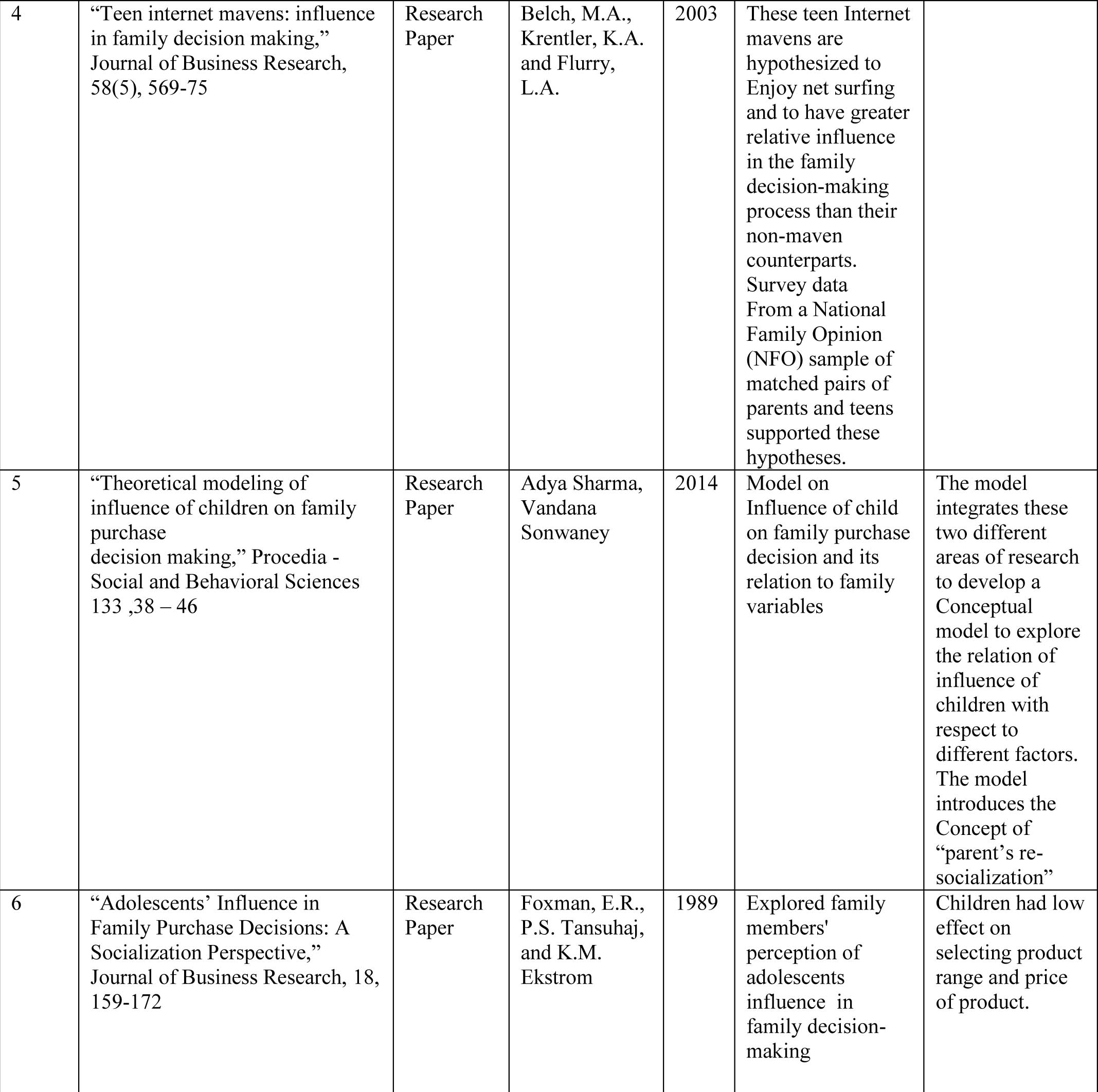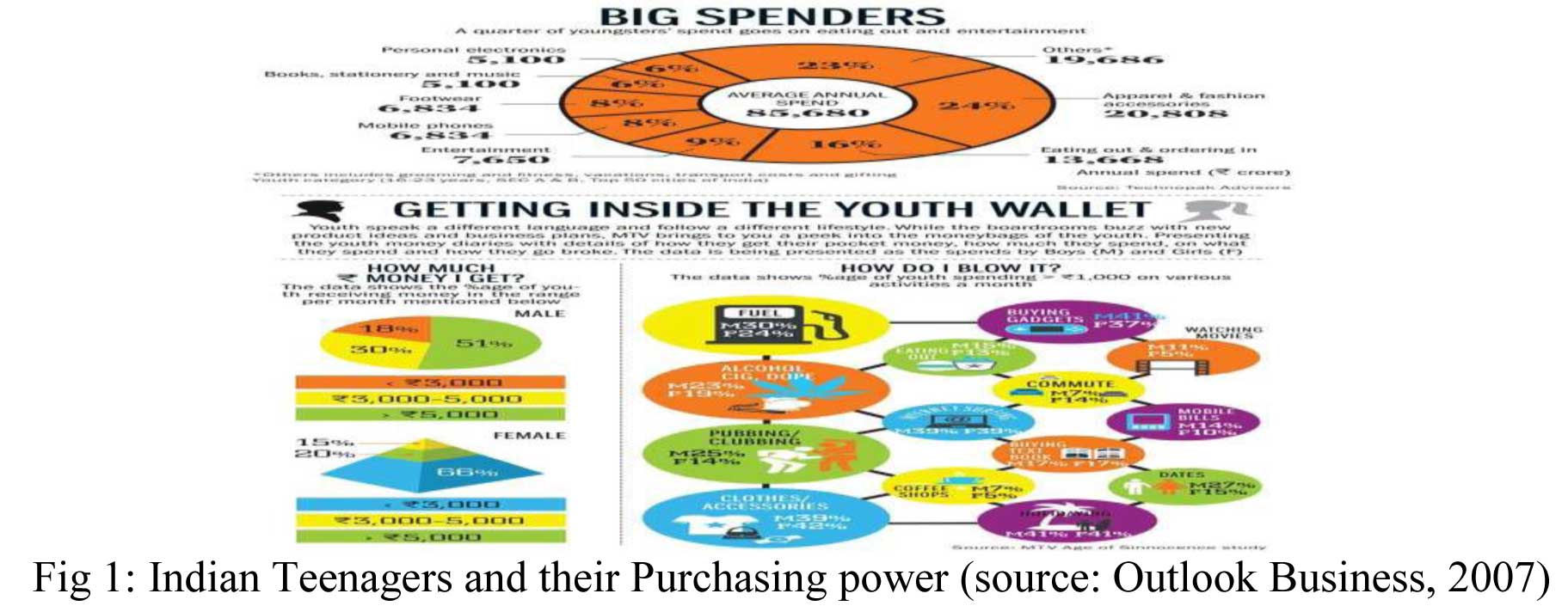Subscribe now to get notified about IU Jharkhand journal updates!
Understanding The Role Of Internet On Purchase Decision Of Teenagers In Patna& Ranchi
Abstract :
In today's world of technology, internet is like daily practice that affects our daily lives. The young generation especially the teenagers are the one who use the internet the most and have positive impact on family decision making. The Rapid emergence of the Social Media and Networking sites as a medium of communication has played a vital role in the purchase related decision and has changed the way consumers buy both in Quantity and Quality. Social Media such as Face book, Twitter, LinkedIn or Instagram have large pool of prospective young consumers say teenagers and they are growing every day. As the usage of internet is growing among the teens, the influence of social media &internet is on a high demand. Internet provides easy accessible information and thus has altered the way purchase decisions are made in families these days. The primary purpose of this paper is to understand the role of internet in purchase decision by the teenagers in Patna and Ranchi. Through review of literature the role of internet and its impact on decision making ability is analyzed. This study will be useful for business operating online, researchers and for all those who have any concern with online purchasing and selling.
Keywords :
Internet, teenagers, family purchase decision, India, Patna, Ranchi.Introduction:
Consumer socialization, defined as the processes by which young people acquire skills, knowledge and attitudes relevant to their functioning as consumers in the marketplace (Ward, 1974), provides a more complete framework for understanding the development of consumption symbolism. Consumer socialization theory predicts that communication among consumers effect their Cognitive, affective and behavioral attitude (Ward, 1974).A Swiss Psychologist Jean Piaget viewed socialization in four phases of a Child Cognitive development(Ward .S, And Daniel, wackman 1972, George .A, 2011).
In the first two stages children have few or less developed cognitive structure and hence assisted purchase is seen repetitive while influence of their peers and parents is highly seen in the later stage. In the third &fourth stage children have the ability to think abstractly and associate concepts and ideas. During fourth stage children also have greater financial resources in some cases and higher cognitive ability to make decision.
Children acquire consumer behavior norms through observation.
- Shopping together with family (Consumer Socialization).
- Copying elders and their behaviors (modeling).
- Peer Group (friends, classmates) also plays a major role.
- Earlier Families considered to be a reliable source of information. With the growth of Internet these behaviors are changing. People check internet first and then decide what to buy.

Relevance of the topic
India has a population of 1.136 billion and 31% of the population comprises of young consumers below 15 years of age and have $10.5 billion spending power which is rising @12% per annum (Adya Sharma, Vandana Sonwaney, 2014).Consumer use internet to accesses updated and transparent information on price, availability of product, features& specification and so on. Consumers want to make sure that they are making the correct choice and thus internet becomes the obvious choice for the same. As per recent BCG surveys, as much as 15% of urban consumers check for information online before making purchase. They set the trend and influence family and friend in purchase related decision. (Source: BCG report, 2015)
Internet penetration in India is driven largely by mobile phones, with some of the cheapest and most basic hand-sets today offering access to the internet. India has 110 million mobile internet users of which 25 million are in rural India (approx. 22.7%).which is fairly low when compared to urban cities internet usage. The growth of internet penetration in rural India is driven largely by the mobile phone; 70% of rural India's active internet populations access the web via mobile phones. This may have to do with the difficulty in accessing PCs due to cost .42% of rural India's internet users prefer using the internet in local languages. The high prevalence of content in English is a hurdle for much of rural India. (Source: Internet and Mobile Association of India (IAMAI)and IMRBInternational,2014)
College-goers remain the largest users of the internet in India, followed by young men.70% of online youth in India spend more than 5 hours on the internet in a normal week. Internet access is still predominantly desktop based (41%), however, 36% use laptops and 27% use Smartphone. Facebook is by far the most popular site used (93%), followed by YouTube (87%) and WhatsApp (79%). 10-12 year old social account users report higher daily access to Snapchat, Pinterest,Tinder, Tumblr, and Vine than their teen counterparts, even though the minimum age to register to these social networking sites is 13 years. (Source: Internet & Social Media Usage among youth in India: MacAfee Report).
Teenagers are also called ‟ net generation or cyber-teens’, due to higher use of internet and fast adoption of technology in this age group (Lee, 2003, Ward, 1974). Youngsters use Internet as platform to interact in a better way or to improve daily life activities (Damer, 1998). Young people use internet 38% more than adults. Teenagers spend less time in front of T.V. and more time on internet as compare to adults (Forrester Research, 2000).
The Rapid emergence of the Social Media and Networking sites as a medium of communication has played a vital role in the purchase related decision and has changed the way consumers buy both in Quantity and Quality. Social Media such as Facebook, Twitter, LinkedIn or Instagram have large pool of prospective young consumers say teenagers and they are growing every day.
As the usage of internet is growing among the teens, the influence of social media &internet is on a high. Internet provides easy accessible information and thus has altered the way purchase decisions are made in families these days. Researches indicate that teenagers are more into usage of internet &social media for purchase related decision. Both generations agree that teens know more about the Internet than their parents do the findings and that older children have significantly more influence than younger ones in family purchase decisions (Atkin, 1978; Beatty and Talpade, 1994; Beneke et al., 2011; Darley and Lim, 1986; Hansen et al., 2002; Jenkins, 1979; McNeal, 1969; Mehrotra and Torges, 1977; Nelson, 1978, Rust, 1993; Swinyard and Sim, 1987; Ward and Wackman, 1972).



There is a number of works that is done on children socialization but few works has been done on teenagers in India.
The following diagram shows the actual picture of Indian teenager and their purchasing power (source: Outlook business, 2007)

The above image clearly indicates that teenagers are a big market for sellers to tap and also that gender also plays an important role in influencing purchasing decisions of parents. There are certain products for which teenagers are more inclined towards usage of internet and taking purchase related decision. The product categories are as follows:
- Mobile Phones/Smartphone.
- Laptops/Desktop/Tablets.
- Two-Wheelers.(Bike/scooty)
- Television.
- Washing machine.
- Refrigerator.
- Branded Clothes.
- Footwear.
- Movie Tickets.
RESEARCH GAPS
Following research gaps have been identified:- Less study has been conducted on teenagers especially in India.
- Influence of medium of communication has been discussed mostly in relation to TV& advertisements.
- Very few studies which discuss the “consumer socialization” process with reference to Internet and Social Media
- Very few studies which study gender roles in Internet or on purchase behavior.
- Thus the role of the internet as a socialization agent has been less examined in academic literature.
Research Objective & Hypothesis:
Research objectives are as follows:- To identify the role of internet and social media on purchase decision process of teenagers (13-19 years)
- To study the extent of influence played by internet and social media at different stages of buying.
- To study any major differences between the genders and influence of Internet / social media on purchase
- To study level of product involvement that affect interaction on social media.
Research hypotheses:
H1: Social Media is positively related to teenager’s role in decision making in purchase related decision. H2: Extent of influence of teenagers in family purchase is high. H3: Gender effect will have varying effect on purchase decision and will depend on product category.
Ticket prices
It’s true that India’s population is in a middle class of between 50 million to 100 million people who cannot afford to pay more than the average ticket price of 150 to 250 rupees (US$2.25 to $3.80). This survey tried to find out how much influence the ticket prices have on the audience to visit the theatres to watch films. The following were the results. The research clearly indicates that 90 per cent of the audiences are affected by the ticket prices either fairly or moderately or heavily. It is clear that ticket prices are the biggest factor to visit theatres by audience to view films and hence this high percentage of audience seeking lower ticket prices to visit theatres more often.
Almost 95 per cent of the movie going audience have to pay Rs.80 and above to watch a film. Currently 55 per cent of the audience pay Rs.120 and above to watch a film in theatres. The survey tried to find out the ticket prices, the respondents are willing to pay to visit the theatres more. The results revealed some surprises. Clearly the Indian audiences are not prepared to pay more than Rs.120 to watch a film in theatres. Large section of audience, 71 per cent wish to pay between Rs.80 to 120 for tickets and nothing beyond and resent ticket charges higher than that and consider it as an impediment to watch films in theatres. 21 per cent of the respondents actually look for ticket prices within Rs.80 is an indication of their comfort level. Only 9 per cent respondents are interested to pay beyond Rs.120 as ticket prices.
Michael Cieply’s report (July 31, 2011, article link 3) on the Hollywood box office revenues revealed the same expectation of the audience in USA/North America and stated that the audience are willing to watch four times a month, against twice a month (which is double the theatre visits) if the ticket prices are less. If the audience in developed nations is looking for reduced ticket prices to view films more in theatres, it is not a surprise when the Indian audience looks for lower ticket prices.
Taxes are too high. Unlike any other business in India, movies must pay both an Entertainment Tax, which would seem to classify them as a frivolous activity, outside the ambit of a necessary service, and they must also pay Service Tax, which implies they are necessary. Several levies, central as well as state, are charged in the media and entertainment industry with central levies being Central Excise duty, Customs duty and Service Tax and State levies being state-VAT and Entertainment tax. The Service Tax and state-VAT onof these taxes are applicable on remunerations, film production, in-film placements, grant of various rights such as distribution rights, theatrical rights, cable and satellite rights, sale of airtime for advertisement purposes, recording/editing of program, sale/lease of program content, etc. These taxes are increasingly being disputed with authorities.
Conclusion:
- The research findings shall help companies to develop strategies for specific product to target teenagers that use internet for most purchase and if teenagers are their future/prospective customers even then business using web base can utilize the study.
- It will also give valuable insight to e-commerce companies to develop their website in accordance to consumer’s perception and ease of access for young consumers.
- The result is also useful for marketers in suggesting that consumers with high product involvement will have different means of evaluation and hence purchase products. Thus level of product involvement can be used by market practitioner as means of target audience segmentation in online shopping environment.
References
- Christina K. C. Lee and Denise M. Conroy, Cecilia Hi (2003), “The Internet: A Consumer Socialization Agent for Teenagers.” Research Paper ANZMAC 2003 Conference Proceedings Adelaide.
- Dotson, M.J. and Hyatt, E.M (2005), “ Major influence factors in children s consumer socialization”, Journal of Consumer Marketing, Vol.22,No. 1, pp. 35 42.
- Kotler, P., and Armstrong, G (2011), Principles of Marketing, 14th Edition, Pearson Prentice Hall.
- Moschis, G. P (1985) , “The role of family communication in consumer socialization of children and adolescents. Journal of Consumer Research”, Vol.11, pp. 898-913.
- Moschis, G. P., & Churchill, G. A., Jr (1978), “Consumer socialization: A theoretical and empirical analysis”,Journal of Marketing Research, Vol.15, pp.599-609.
- Roedder-John, D (1999), “Consumer socialization of children: A retrospective look at twenty five years of research”, Journal of Consumer research, Vol.26, pp.183-213.
- Ward, S (1974), “Consumer Socialization”, Journal of Consumer Research, pp.1-14.
- Ward, S.,& Wackman, D. B (1971), “Family and media influences on adolescent consumer learning”, American Behavioral Scientist, 14, pp. 415-427.
